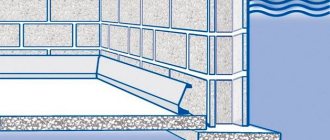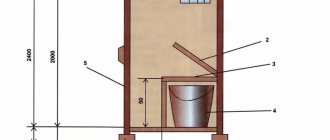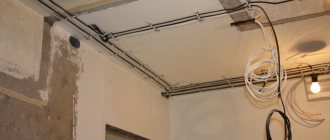In old houses, failure of the water supply system is a common occurrence. And installing an internal pipeline from modern materials or purchasing new plumbing fixtures does not solve the problem.
Only a complete replacement of the water supply risers in the apartment helps. If you have already encountered a similar problem and don’t know where to start, we will help you figure it out. The article will discuss what requirements should be observed when replacing risers, what stages the installation involves connecting the system and what materials will be needed for this.
Reasons for installing a new riser
The need to replace a vertical pipeline arises in two cases: after the expiration date of the metal structure and when performing a complete renovation of the bathroom.
Depending on the conditions, its replacement is performed in one of two modes:
- planned - when water pipes are worn out;
- emergency - when a malfunction occurs and a leak occurs.
In old houses, the “original” apartment risers are made of galvanized or cast iron pipes. Metal structures are susceptible to corrosion and therefore require replacement.
Corrosion is the main enemy of cast iron and steel pipelines; it “corrodes” and corrodes risers with hot water supply faster than with cold water
It has been noticed that pipes wear out the most in interfloor ceilings. Therefore, the joining of the new pipe to the old one should be done outside the ceiling: in the bathroom of neighbors living on the floor below or above.
For metal pipes, the service life is about a quarter of a century. In reality they last much longer. But after forty years of service they fall into disrepair.
The use of metal pipes after the warranty period is not recommended for the reason that they can break at the most unexpected moment
Even if the pipes look intact after the end of the operational period, it is still recommended to replace them. This is explained by the fact that a pipe worn out over time can burst at any time, which will lead to great material damage both for the owners of the apartment and for neighbors affected by flooding.
As planned, it is recommended to replace pipes at the stage of major repairs. When arranging modern interiors, it is customary to “hide” the pipeline in the wall, and therefore getting to it in the event of an emergency will not be easy.
If you dream of installing a new jacuzzi or purchasing auxiliary equipment for the bathroom, then moving the vertical pipeline cannot be avoided
Cast iron pipes are usually replaced with polypropylene analogues. And this choice is fully justified by a number of undeniable advantages that the polymer has.
These include:
- resistance to corrosion and aggressive influences;
- smoothness of the inner walls, preventing the accumulation of limescale on the inner surface of the pipeline;
- high strength;
- environmental Safety.
For arranging a pipeline with cold water, ordinary metal-plastic and polypropylene pipes of the appropriate diameter are suitable, and for supplying hot water, pipes intended for heating systems are suitable. They are characterized by higher strength and increased resistance to deformation.
Manufacturers of polypropylene pipes claim that the service life of products is about 50 years, and those used to supply cold water are about 100 years.
The internal surface of polypropylene pipes, which is in contact with drinking water, meets all sanitary standards, and the internal diameter of the products does not change during operation
Compared to metal structures, installation of polypropylene pipes takes much less time. The use of welding technology makes it possible to obtain a strong and reliable connection with minimal effort.
What to do if neighbors are against renovation?
Conduct explanatory conversations with neighbors who do not understand the consequences, expressing their protest. If no action is taken, the management company will go to court on the basis of Art. 212 Code of Civil Procedure. Next, the court will order the owner to provide access to the premises for repair work. Of course, the trial is not a quick or particularly pleasant matter, but it is the only way to speed up the process of all work and avoid an emergency situation throughout the house. But, in case of dishonest performance by the management company itself, feel free to file a complaint with the supervisory authorities (GZHI).
Why is it important to understand pipes and what types there are?
Understanding how the pipes run and how the water supply system is built, different repair methods are used. As a rule, in houses with different periods of construction and regional-territorial location, I distinguish between horizontal main pipelines and vertical distribution risers passing through the floors. Let's start with the connection system.
Dead-end systems, the most common method of using cold water supply is a bottom supply main. It has a weak pressure to the upper floors. In four-story brick houses and Khrushchev-era panel buildings you can find dead-end hot water supply systems.
The first disadvantage of this method is that there is no water supply and the water in the pipes cools down. This risks the fact that one of the residents will spend a long time “draining” and “warming up” the water, while overpaying. The second minus is that heated towel rails connected to heat the bathroom also take away heat and warm it up when water is drawn off.
Circulation (loop) systems have a two-pipe classical system with a supply line and a “return” leading to a heat source. The heat supply scheme can be open (in which hot water is sent directly from the boiler room) and closed (i.e., the water goes to individual heating points, where it is already heated)
Features of connecting to the wiring
In the place where the vertical pipeline will connect to the wiring in the apartment, install a tee measuring 32/20/32. To facilitate installation of the tee, its end is lubricated with liquid soap. The elements are fixed by soldering.
When planning to install a heated towel rail in the bathroom, two additional tees are installed on the pipeline
An important point: when installing tees, it is preferable not to use a coupling, but a soldered connection.
After installing the shut-off valve, check for leaks. If there is none, fix the assembled structure to the wall.
To do this, using a building level, pre-mark points in the wall for making holes for installing clips. Fastening elements are placed every 100-150 cm.
From the moment the last connection is made, the installed section of the network can be filled with water no earlier than an hour later. To ensure a sufficient level of moisture resistance and sound absorption, the places where pipes pass through the ceilings are concreted throughout the entire thickness. These and other finishing activities are carried out only after testing the structure.
Areas of responsibility
- By whom and at whose expense is the repair or replacement of water supply pipes in the apartment carried out?
The liners are the personal property of the homeowner, while the risers are the common property of the residents of the house. The boundary of the areas of responsibility passes through the connection in front of the tap or valve at the outlet from the riser.
If the tap or supply line is faulty, all repair work is carried out by the apartment owner at his own expense; Leaks and other faults in the riser are eliminated by the management company.
The boundary of the areas of responsibility runs along the connection of the cranes to the branches from the riser
Types of drainage systems
When developing a sewerage system in the basement of a private house, remember that it can be combined or separate. In the first case, the system is a single pressure line. In the second case, there will be 2 autonomous systems: one pumps relatively clean wastewater, the second pumps feces.
Clean wastewater can be removed using a standard pump. When their volume is small, a sololift is suitable. How to decide what type of sewer system to install: combined or separate? To do this, compare the volume of clean and dirty wastewater.
When there is no mini-pool, shower, bathroom or sauna in the basement, there is no need for wastewater separation. In this case, it is enough to install a sololift or a pump with a small storage tank to drain the wastewater to the central riser.
However, if the volume of wastewater is large, for example, there is a swimming pool on the ground floor, the sewage system must be separate: a pipeline for clean wastewater is equipped with additional intermediate storage tanks.
This step is necessary because the reservoirs built into pumping stations have a small volume and will not be enough. In order for the equipment to work properly, additional storage tanks are installed to pump out a large volume of wastewater.
Street
Small-diameter pipes have to be replaced on the street only by owners of private houses. Everything is simple: take a shovel, dig a trench, cut off a piece of old rusty pipe with a turbine and install a new one in its place. What about apartment buildings, neighborhoods and neighborhoods?
Typically, the replacement of communications in these cases is carried out not by private individuals, but by organizations armed with heavy equipment. There are two main ways to repair pipelines:
Digging a trench
Does it make sense to describe what makes us happy in our hometown many times a year? Traffic is blocked, an excavator and a team of intellectuals of unknown age with shovels are brought in, after which a flowering lawn or smooth asphalt turns into a sinkhole with a dirty puddle at the bottom.
Occasionally, the landscape is decorated with a car flying into a hole due to lack of lighting and its happy owner, who is in a hurry to share his knowledge in the field of folklore with others.
Familiar to everyone
HDD and other bloodless methods
Recently, especially in large cities, trenches have begun to be replaced by special horizontal drilling units.
Trenchless pipe replacement also requires heavy equipment, but there is no need to block traffic and dig up the street: the soil is pierced with a special drill under the surface, after which the pipe is pulled through a horizontal channel.
There are two ways to replace an old water supply:
- The injected air powers a pneumatic, self-contained breaker that breaks up the old pipe, widens the channel around it, and compacts the surrounding soil. A pipe of the same or larger diameter is then pulled through such a channel. This method can replace a pipeline made of concrete, asbestos cement or cast iron.
- Overgrown old steel pipes are cleaned of accumulated deposits, after which a plastic pipe of smaller diameter is pulled through the gap. Considering the lower resistance to water flow of smooth plastic and the lack of overgrowing, this is often more than enough.
And no holes in the middle of the road
Backflow protection
If you want to make a sewer system in the basement of a private house with your own hands, take the installation of the pipeline seriously. Since the pipeline will be located in the basement, blockages may occur. The sewer system will constantly overflow.
As a result, backflow may occur - because the system is overfilled, wastewater will begin to flow back, and the basement will be flooded with foul-smelling sewage. To prevent this from happening, follow these recommendations:
- Install equipment with built-in current resistance . There are many models of such stations on sale; check with your sales consultant for the availability of this function.
- Install additional storage tanks that block valves, which will prevent the formation of reverse current . This solution has one drawback: sewerage clogs may form in the basement.
Many experts are confident that the risk of reverse current is small and it is not advisable to provide additional protection against it. Others argue that it is better to play it safe and purchase all the necessary equipment to make living in the house comfortable and safe.
When is it necessary to change?
The service life of steel water pipes is 25 years for hot water and 30 years for cold water.
Plastic pipes have a 50-year lifespan. But these deadlines may turn out to be much shorter. There are many reasons for this, the main one being poor water quality.
Should pipes be replaced after the standard service life has expired?
No, they shouldn't. Attention! The basis for replacement is the conclusion of the commission, on the grounds indicated below.
The regulatory period itself serves only as a guideline for making a decision, but is not a sufficient basis. Replacement of hot and cold water riser pipes should be done in the following cases:
- the water pressure at the point of analysis dropped to a minimum of 0.3 kgf/cm2, and cleaning the pipes did not give a positive result;
- water consumption at the point of analysis is very low, less than 2 liters per minute, when the tap or mixer is fully open;
- through holes (fistula) with traces of corrosion appear on the walls of the pipe, leading to leaks;
- the thickness of the pipe walls decreased by 2 times as a result of corrosion;
- Numerous requests and complaints began to be received about low pressure and leaks.
Cost of work
The price of the work depends on the type of piping, the scope of work and the materials used. In the standard case described above, for large cities in the central part of Russia, the cost starts from 3,000 rubles for 1 riser and 1 floor.
This is the cost excluding materials, but including the cost of dismantling pipes. Costs for materials can range from 1,000 rubles, without shut-off valves, and up to 2,000 rubles with taps.
Table with costs:
| Name | Purpose | quantity per 1st floor | unit price RUR | total cost RUR |
| Pipe d 32 mm, meter | supply riser | 3,0 | 85 | 250 |
| Pipe d 25 mm, meter | reverse riser | 3,0 | 50 | 150 |
| Sleeve, pcs. | into the ceiling | 2 | 20 | 40 |
| Tee 32x20x32, pcs. | transfer to the apartment | 1 | 30 | 30 |
| Tee 25x20x25, pcs. | heated towel rail | 2 | 15 | 30 |
| Connector with American, pcs. | 1 for input and 2 for drying | 3 | 120 | 360 |
| Consumables | mortar, sealant, etc. | 130 | 130 | |
| Total materials | 990 | |||
| Drying taps | heated towel rail | 2 | 350 | 750 |
| Total | 1740 |
Reference! In total, replacing a hot water riser can cost from 4,000 to 6,000 rubles per apartment.
How to replace a water supply riser in an apartment
Water supply risers are located in bathrooms at a short distance from the wall. A shut-off valve must be placed on the riser, which is necessary to shut off the water supply.
When repairing water supply pipes, it is recommended to replace the entire span at once, but this is not always possible. In this case, you need to replace at least the section of the riser between the floor and the ceiling. It is impossible to replace only a small section of pipe that has rusted.
When replacing water supply structures in an apartment building, it is necessary to notify other residents about the time of the work. You will also need to contact neighbors living directly above and below you for permission to carry out work on their property if necessary, since the new structures will go through the floors.
Neighbors have the right to refuse, in this case you will have to work only within the confines of your apartment - in the area from floor to ceiling in the bathroom. It is very important that free access is provided to the pipe joining points. This will allow you to quickly fix a leak if it occurs.
Take the test
The housing department is obliged to replace the water supply riser in the apartment as requested in your application, if you have drawn up the document correctly and provided serious facts that comply with the law as evidence. Otherwise, you have the right to request a written refusal from the management company, which will contain the reasons for such a decision.
If you do not agree with the decision made, then you should write another statement - to the prosecutor's office. It is worth adding to the paper all the documents related to this problem that you have in your hands. Also, according to the law, it is possible to replace the water supply riser in an apartment without the appropriate permission, while work to replace the equipment must be authorized by the owner of the property.
Stage No. 1 – selection of materials.
After agreeing on all the nuances with the management company and neighbors, you can begin drawing up a diagram. This is necessary in order to find out the specifics of the pipeline layout in the bathroom, as well as find out how much materials you will need.
To replace the water supply riser in an apartment you will need:
- polypropylene pipes D 25 mm (or 32 mm);
- fittings of the appropriate diameter;
- metal clamps;
- silicone sealant.
To install a vertical pipeline, you should choose pipes of the same diameter as those of the elements that are to be replaced.
To connect parts of the structure, expansion joints D 25 mm (or 32 mm) and couplings are used, and transition collars are used to connect plastic and steel pipes to each other.
In the old housing stock, VGP steel pipes were used to supply gas, water and heat to apartments, so it is easier and more expedient to choose structural elements made of the same material when replacing equipment.
You also need to plan the final design of the riser - decide whether you will do heat and sound insulation, what the box will look like.
To work you need the following tools:
|
In addition, it is worth preparing protective equipment: heat-protective gloves, construction glasses, a respirator and a hat.
You may also need several plastic outlets with a diameter of 10 cm and an angle of 45 ° C. They are used in cases of displacement or alignment of a vertical pipeline. Another necessary tool is a soldering iron with different-sized Teflon nozzles - it is needed for welding polypropylene pipes.
As a rule, the management company replaces the water supply riser on weekdays between 10 a.m. and 3 p.m. At this time, most people are at work, and therefore they will not experience discomfort in connection with the work.
You cannot block the riser on your own; to do this, you should contact a specialist. Typically, the entire process of replacing the water supply riser in an apartment takes from half an hour to an hour. However, excessive haste may cause you to miss some important nuances.
You can make it easier to replace cast iron pipes by using a pipe cutter. This tool is equipped with cutting rollers/rollers, resulting in smooth edges at the cut site.
Stage No. 2 - dismantling old pipes.
The work associated with dismantling a vertical pipeline from a water-gas steel pipe is one of the most difficult in the plumbing industry. These operations can only be performed correctly by experienced specialists who know how to handle power tools. Also, when working, you should strictly adhere to labor protection requirements.
The quality of the installation of the new one depends on whether the old pipeline was disassembled correctly.
First of all, you should shut off the riser and drain the water. This should be handled by a housing office employee. If you try to do this yourself, you will receive an administrative fine.
Next, using a grinder or pipe cutter, you should dismantle the old structures. For this purpose, make 2 horizontal cuts (10–15 cm long), which converge at the edge of the pipe adjacent to the wall. To avoid subsidence of the upper part of the pipe, the initial cuts are not made completely.
To remove the cut section, you can make additional vertical cuts or drive in wedges. A section of pipe is cut from above to a calculated height, which is equal to the length of the shaped part intended for pressing during installation. The specialist must ensure that the cut plane is perpendicular to the internal axis of the pipe.
To make this operation easier, it is recommended to use masking tape: you should glue it in an even ring (the beginning and end must match exactly).
To remove the lower part of the pipe, carefully loosen it. The main thing is that the bell remains intact. Then the solution should be hollowed out around the perimeter. Armed with a wedge or crowbar, they take out the cut off parts.
Previously, joining of cast iron pipes was carried out using one of the following methods:
- through the use of sand-cement mortar for caulking seams;
- using sulfur for filling.
You can clean the pipe from hardened cement mortar by picking at the surface of the seam with a screwdriver. The easiest way to remove sulfur is by burning it off: to do this, you need to heat the parts of the water supply riser structure with a soldering iron. In order to control the draft in the riser, you should place a metal or asbestos-cement shield on top of the pipe. Having warmed up the riser, you can easily disassemble it at the joints.
You can remove the parts obtained after cutting the pipe using a screwdriver. If any elements are stuck, they are knocked out with a hammer. In the resulting free space, markings are made for clips intended for fixing pipes in the wall at the distribution points.
Stage No. 3 – installation of a new pipeline.
At this stage, they cut pipes to the required length. To do this, use a hacksaw or scissors for cutting polypropylene. At the junctions of structural parts, marks are made to indicate the connection point.
You should pay attention to what material your neighbors' water supply risers are made of. If they are metal, then you should analyze whether their condition allows threading from the end side. You can make cutting easier by lubricating the end of the pipe with machine oil.
Taking a grinder with a grinding disc, you should trim and remove the conical chamfer from the cut of the pipe along the entire perimeter. Sometimes the existing metal pipe may seem unreliable. In this case, to avoid the risk of damage, you should simply take the finished thread (5-7 turns) and weld it. An alternative solution could be to join the parts using a collet coupling, to which, in turn, attach an adapter coupling with a thread suitable for mounting plastic pipes.
When installing the pipes, apply little force when tightening. This effect is created artificially by placing linen winding at the joints and coating them with investment paste. Before placing the adapter on the cast iron pipe, sealant is applied to the joint.
It is much easier to connect two plastic elements - the joints are first cleaned and degreased with an alcohol composition.
To weld polypropylene pipes to each other, you need a welding iron with a Teflon nozzle. Welding occurs at a temperature of approximately 250 °C. Both the fitting and the end of the pipe should be placed on the heated device to the full depth of the nozzle. After this, the structural parts must heat up properly, and only after that they are removed and joined to each other.











